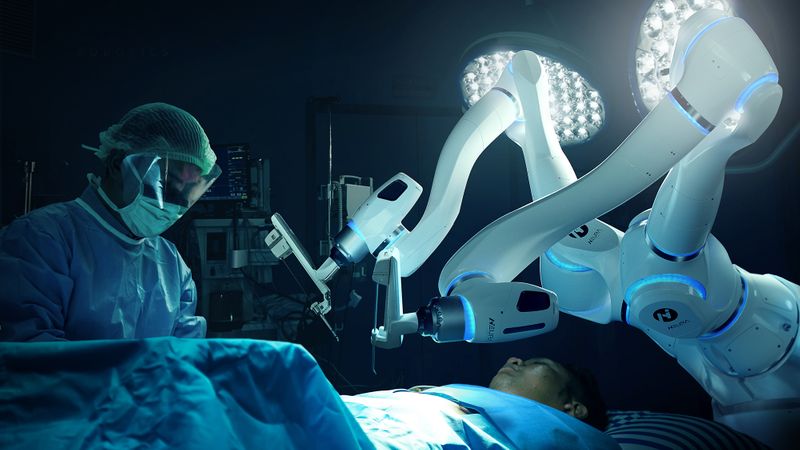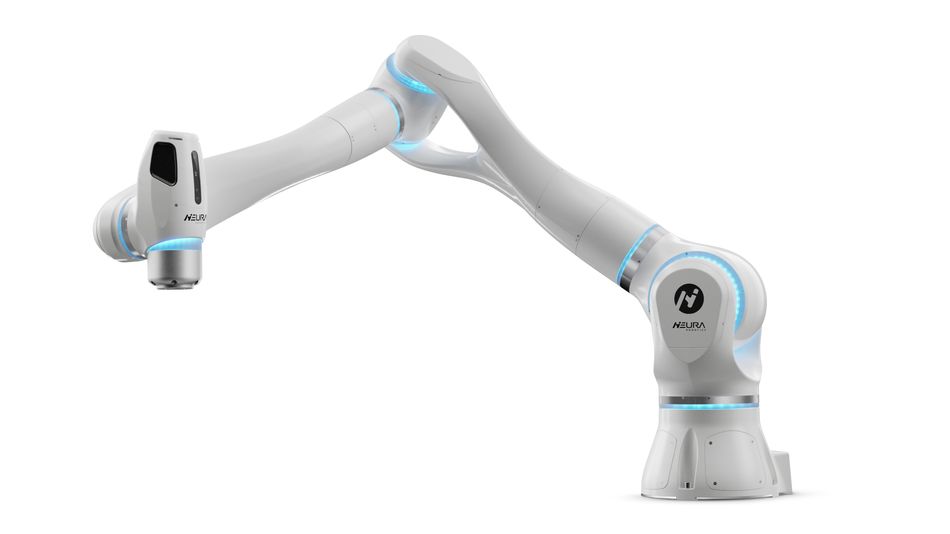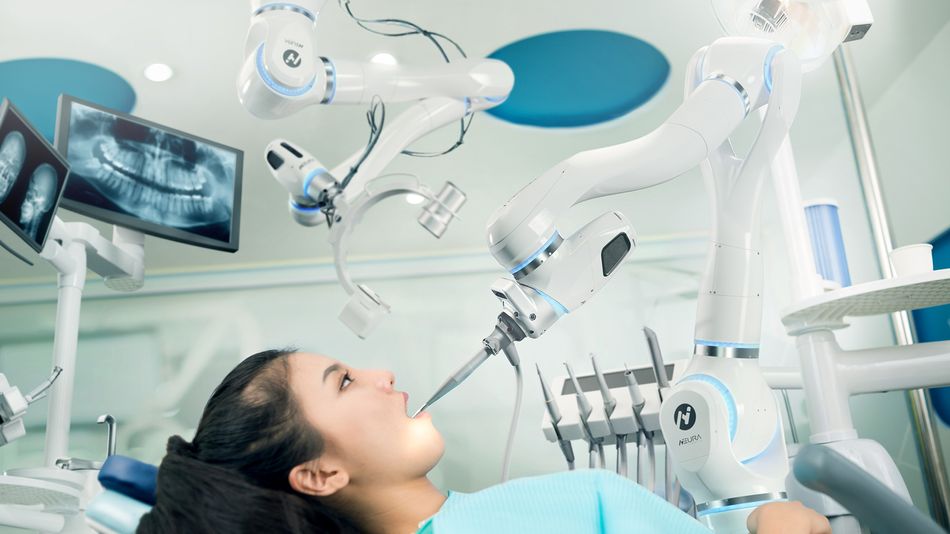MAiRA Smart Cobot Promises Next-Level Cognition and Interaction
Advanced sensors and sophisticated AI power intuitive robotic assistant.

MAiRA robot in a medical setting. Image credit: Neura Robotics.
What is a Cobot?
Cobot is short for collaborative robot and they are designed to work directly with people within a shared space. In comparison to traditional industrial robots, cobots utilize force feedback to detect collisions to ensure that no humans collaborating with the robot get harmed because of a potential impact. They are often designed with rounded or soft features and can only be operated with lower speeds (unless they are behind fences) to prevent injuries to people.
Cobots can complete high precision and heavy-duty tasks with minimal oversight. Their function is to complement human skills, not to be a replacement for human workers. Hence, intuitive low code programming opportunities are a vital component to achieve a high acceptance from the users. Cobots are smaller, lightweight, and significantly more affordable than earlier industrial robots. Working alongside humans, they increase productivity and help to create safer, more efficient workplaces.
Industrie 4.0, also known as the Fourth Industrial Revolution, is the next movement in manufacturing. It’s the convergence of several technologies that combine continuous data gathering and artificial intelligence (AI) to be more agile, responsive, and customizable than traditional manufacturing. Collaborative robotics is an essential Industrie 4.0 technology. As Industrie 4.0 marches forward and AI continues to mature, more intelligent and capable cobots are on the verge of becoming ever-present.
What is MAiRA?
The Multi-sensing Intelligent Robotic Assistant (MAiRA) is the new cognitive cobot from German-based NEURA robotics. It delivers previously unseen features for cobots that will push them towards the goal of making them smarter, more user-friendly, and autonomous. moving them beyond industrial applications and into homes, healthcare, retail, and office spaces.
Safety enables close working conditions
MAiRA is equipped with an integrated proprietary sensor system that enables “Touchless Safe Human Detection.” The sensors can detect and distinguish people from other objects within a 3 meter range and provide instructions to the robot to change direction, slow down or stop. The sensor system provides a secure and robust 360° view and doesn’t struggle with problems like occlusion, dirt, or bad lighting conditions.
This makes human collaboration with MAiRA much easier, safer, and more intuitive. While not having the safety fences of traditional industrial robots, cobots still must operate under complex safety rules and regulations that reduce the danger of harm for collaborative tasks.
MAiRA’s extensive safety features based on the safe human detection feature allow a much closer physical interaction without the normally required risk assessment. The impact of this type of sensor in collaborative robotics is not to be underestimated. Current regulations are prohibitively restrictive and compulsory for most international markets. Any change to the operating environment, the cobot’s gripper, or other components affects the risk assessment of the robot. MAiRA's advanced system enables it to be employed more quickly and easily through a variety of settings.
Intuitive interaction and contextual awareness
MAiRA is also equipped with advanced speech recognition enabling her collaborators to interact and give commands using voice. It also enables the cobot to recognize and track people using their voice or other sounds. Voice commands are a critical aspect of future cobots and other assistive technologies. Voice is perhaps our most intuitive method of communication and something that we constantly utilize when working in partnerships. MAiRA’s voice capabilities elevate its usefulness in industrial and healthcare settings where a person’s hands are likely to be already engaged in another activity. Voice is also a huge benefit when thinking about the role of cobots in personal healthcare; users with limited mobility can interact and command MAiRA without moving.
Giving cobots cognition
In addition to its voice capabilities, MAiRA is powered by an Intelligent Cognitive Robot Controller, called NEURON. This modular system enables MAiRA to understand her environment even when there are minute changes and adjust her own tasks or movements to be able to continue to operate at the highest productivity.
MAiRA In-Depth
The MAiRA Pro M has a reach of 1,400mm, repeatability of 10µm, and a dynamic payload of up to 12-15kg. Repeatability in cobots is its ability to achieve repetition of the same task. MAiRA’s NEURA encoders have a resolution of 24 bits. This coupled with high precision NEURA motors allows for 0.1mm absolute accuracy and 0.2mm path accuracy. Path accuracy is the difference between the robot's actually traveled trajectory and its precalculated trajectory. MAiRA’s high accuracy and repeatability mean the cobot is extremely good at hitting its target and doing it repeatedly. This opens up many use cases to MAiRA which can not be performed with other cobots.

The MAiRA cobot can be further customized with a suite of perception sensors depending on the client’s needs. These advanced sensors consist of a 3D RGB-D camera, six degrees of freedom (6-DOF) Force/Torque sensor, Smart Sensitive 6-DOF Sensor Skin for guidance by touch, 3D Voice Recognition Sensor, and Touchless Safe Human Detection. All of these sensors contribute to the cobot’s ability to map out its environment and react to it. This leads to a cobot that can avoid dangerous interactions with humans and perform dull, dirty, and dangerous jobs without excessive human intervention which opens up the workers to pursue more creative tasks.
Drag and drop programming
MAiRA comes equipped with an Intelligent UX Control Tablet called PERSPECTiVE, with a 10.1” touchscreen, running on the NEURON OS operating system. PERSPECTiVE also features a dead-man switch and an emergency button for an additional level of safety. The app-based interface is intuitive and requires no coding. Commands are drag and drop. This makes MAiRA more accessible to a wide range of users as it requires less training to operate than traditional cobots. And for more control, advanced users can program the robot in Python.
Advanced AI, easy programmability, capacitive and voice sensors for guidance, combined with the 360° sensor makes MAiRA easy to use and safe. Essentially, this would allow anyone to operate MAiRA with limited training. Interactions with the robot are intuitive, so that it becomes more of a helper, and not a machine meant to replace workers. Exactly how cobots and other automation tools will replace or augment human workers is a critical topic to consider. MAiRA’s intuitive programming ability means almost anyone can learn the skills and tools required to play a role in the maintenance and operation of the cobot.
Where Will MAiRA Work?
Of course, MAiRA is perfectly capable of working on the factory floor. Its high accuracy and repeatability make it ideal for pick and place. For example, it can be trained with a step-by-step wizard to recognize and identify objects and it learns with every training session to grasp different objects independently.
MAiRA can get moving when paired with the Multisensing Autonomous Vehicle (MAV), an Autonomous Mobile Robot (AMR) that is also designed to collaborate with humans. MAiRA, can be mounted onto the MAV robot to become a mobile manipulator. This opens up a wide range of applications for these cobots. Combined with MAV, MAiRA can organize the warehouse or stock the shelves of a supermarket.
Its advanced AI and sensing capabilities help MAiRA work in challenging environments, and its ability to interact with people safely makes it a perfect robotic assistant for surgical and medical screening, and for use in dentistry. This frees up healthcare workers from doing mundane, routine tasks. Their skills and highly valuable time can be spent on more pressing matters. As we have an aging population and not nearly enough caregivers, MAiRA will be invaluable for eldercare.

Looking Forward
MAiRA brings cobots one step closer to full automation but is designed to work with people, not to replace them. Future versions of MAiRA will bring more capabilities to the cobot. Next year there are several new iterations of the cobot and its kin. A double arm version of MAiRA enhances its utility.
A smaller version, the MAiRA Jr., is planned for the education sector and a more compact and agile MAV Jr. is in the works. Designed for smaller payloads, it could be paired with MAiRA to make an even friendlier, more useful assistant for all aspects of our lives. There is a real need for small, affordable, and lightweight cobots in these difficult times. Imagine a fleet of cobots preparing or even administering COVID vaccines. That would certainly help speed up the process of getting to herd immunity.
Cobots have the potential to change our lives for the better by speeding up production safely and providing assistance in a wide range of applications. Intuitive controls, multi-sensing, and a powerful, teachable AI, makes MAiRA a better cobot. Enhanced safety features and the ability to safely interact with humans, allow this cognitive cobot to move beyond the limits of industrial settings. MAiRA can safely operate in offices, classrooms, and even in our homes. Soon, cobots like this will be ubiquitous enabling a new era of collaboration.